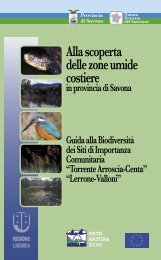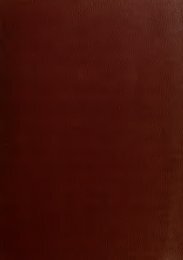Steiner G. & Kabat A. R.<strong>species</strong>. The entries are alphabetically ordered bytheir original binomen following the scheme:<strong>species</strong>, original genus Author, year: page. Stratigraphy<strong>of</strong> type locality. Type locality [translatedinto English <strong>and</strong>/or modern equivalent as needed].Depository <strong>of</strong> type material. Synonymy.Current taxonomic status (reference if differentfrom original combination). Geographic distribution.Bathymetric range. Remarks.Names <strong>of</strong> valid <strong>Recent</strong> <strong>species</strong> are in boldface.Names <strong>of</strong> the 816 valid <strong>fossil</strong> <strong>species</strong>-<strong>group</strong><strong>names</strong> are preceded by a dagger (†) symbol. Thesynonymies given are based upon publisheddeterminations. Where contradictory opinionshave been published, one is given preference <strong>and</strong>the alternative is noted in the Remarks.Synonymies, current status <strong>and</strong> distribution aregiven only for a few <strong>fossil</strong> taxa. Synonymies donot include misidentifications, as their completelisting is beyond the scope <strong>of</strong> this paper. We havenot attempted to resolve all transfers <strong>of</strong> syntypes<strong>and</strong> paratypes subsequent to the original descriptions,a problem caused by the fact that suchtypes were sometimes split <strong>of</strong>f from the originallots long after the original descriptions (especiallyat the museums <strong>of</strong> the United States <strong>of</strong> America);thus, types are <strong>of</strong>ten located in depositories notcited in the original publication. Additionalinformation such as modern locality <strong>names</strong>,depths in m, references cited by Linnaeus <strong>and</strong>Gmelin, etc., is given in square brackets. Boss(1988) provided full references for the <strong>of</strong>tencrypticabbreviations used by Linnaeus (1758,1767) <strong>and</strong> many <strong>of</strong> those used by Gmelin(1791). Current generic assignments are tentativefor many <strong>species</strong> due to the lack <strong>of</strong> anatomicaldata needed to distinguish certain genera.The generic assignments <strong>of</strong> <strong>Recent</strong> <strong>species</strong> thathave not been recently studied were based uponthe generic diagnoses in Scarabino (1995). Informationon bathymetric ranges can be problematic,since published records do not alwaysdifferentiate between live-collected specimens<strong>and</strong> empty shells, the latter <strong>of</strong> which can betransported to deeper depths before beingdredged. Hence, researchers interested in determiningthe bathymetric range for a given <strong>species</strong>are advised to examine the relevant specimens inmuseum collections to ascertain their taphonomicstatus.For the sake <strong>of</strong> completeness, we have includedincorrect subsequent spellings in this catalog.They refer to the corresponding valid name.Although these are not available <strong>names</strong> (ICZN1999: article 33.3), their inclusion herein willreadily allow future generations <strong>of</strong> researcherswho find these <strong>names</strong> in the older literature todetermine their status from this catalog.Table 1 lists the abbreviations <strong>of</strong> type specimendepositories taken from Kabat & Boss (1992:188-232), with some additions. The currentdepositories <strong>of</strong> type material were, in some cases,difficult to determine. Information was obtainedfrom the original descriptions, from catalogs <strong>of</strong>type specimens, on-line searches in museumdatabases, correspondence with curators, <strong>and</strong>from visits to The Natural History Museum(London), Muséum national d’Histoire naturelle(Paris), <strong>and</strong> the National Museum <strong>of</strong> NaturalHistory (Washington, D.C.). The most importantlists <strong>of</strong> types <strong>of</strong> <strong>Recent</strong> scaphopod <strong>species</strong>,among others listed by Kabat & Boss (1992: 243;1997: 354), are Turner (1955), Palmer (1958),Dance (1967), Zeidler & Macphail (1978), Giles& Gosliner (1983), Oliver (1984), Scott et al.(1990), Spamer & Bogan (1992), Wallin (1992),Kilias (1995), <strong>and</strong> Boyko & Sage (1996). Otherimportant sources <strong>of</strong> information on types <strong>of</strong><strong>fossil</strong> scaphopod <strong>species</strong> are Newton (1891),Beecher (1900), Maury (1917), Rossi Ronchetti(1955), Flügel (1959), Ludbrook (1959), Brann& Kent (1960), Hanzawa et al. (1961), Keyes(1972), Ferrero Mortara et al. (1984), <strong>and</strong> White(1998). It was not always possible to obtain informationon the current status <strong>of</strong> type material (i.e.if a lectotype had been designated) for severaltaxa. If the original publication <strong>and</strong> any relevantsubsequent publications, or correspondence withmuseum curators, did not yield information onthe status <strong>of</strong> type specimens, then the entry reads“Type material in [museum]” without greaterspecificity Due to the relocation <strong>and</strong> re-cataloging<strong>of</strong> the Mollusca collection in the NationalMuseum <strong>of</strong> Natural History (Washington,554ZOOSYSTEMA • 2004 • 26 (4)
Species-<strong>group</strong> <strong>names</strong> <strong>of</strong> <strong>Scaphopoda</strong> (Mollusca)TABLE 2. — Number <strong>of</strong> <strong>species</strong>-<strong>group</strong> <strong>names</strong> <strong>of</strong> <strong>Recent</strong> <strong>and</strong> <strong>fossil</strong> <strong>Scaphopoda</strong> for the most prolific authors, including originaldescriptions <strong>and</strong> replacement <strong>names</strong>. *, including co-authored <strong>species</strong> <strong>names</strong>.<strong>Recent</strong> Fossil TotalAuthor No. Author No. Author No.Henderson 51 Sacco 67 Pilsbry* 99Scarabino 47 Pilsbry* 54 Sacco 67Lamprell & Healy 46 Cossmann* 42 Henderson 51Locard 45 Deshayes 29 Dall 49Pilsbry* 45 Meyer* 20 Scarabino 47Boissevain 39 Martin 19 Lamprell & Healy 46Dall 37 Gardner 18 Locard 45Watson 31 Tate 18 Cossmann* 45Sowerby* 30 Koenen 16Habe* 19 Chenu 14Jeffreys 19 Palmer C. P. 13Plate 17 Dall 12Chistikov 14 D’Orbigny 12Janssen R. 11D.C.), paratype catalog numbers for several<strong>species</strong> (especially <strong>of</strong> Henderson’s types, whichsometimes shared catalog numbers with otherlots) are not available at present.Boissevain (1906), in her monograph on theSiboga Expedition scaphopods, introduced39 <strong>species</strong>-level <strong>names</strong> <strong>of</strong> <strong>Scaphopoda</strong>. Unfortunately,this monograph had a number <strong>of</strong> typographicalerrors regarding the numbers <strong>of</strong>specimens <strong>and</strong> dredging station numbers forsome <strong>of</strong> the type material; furthermore, some lectotypedesignations by subsequent authors havenot always clearly identified the precise specimenthat was to be the lectotype. Robert Moolenbeek<strong>and</strong> A. N. Van der Bijl (ZMA) have thoroughlyreviewed the Siboga type material <strong>and</strong>Boissevain’s annotated copy <strong>of</strong> her monograph.Based upon this review, they have carefully reconciledthe discrepancies in this monograph <strong>and</strong>in the subsequent literature regarding the typematerial. We have incorporated their correctionsinto our catalog.A comparison <strong>of</strong> the most prolific authors <strong>of</strong><strong>Recent</strong> <strong>species</strong> (Table 2) shows that Hendersonintroduced 52 new <strong>names</strong>; Scarabino 47 <strong>names</strong>;Lamprell & Healy 46 <strong>names</strong>; Locard <strong>and</strong> Pilsbry45 <strong>names</strong> each; Boissevain introduced 39 <strong>names</strong><strong>of</strong> <strong>Recent</strong> <strong>species</strong>-<strong>group</strong> taxa. Sacco coined 67<strong>fossil</strong> <strong>species</strong>-<strong>group</strong> <strong>names</strong>; Pilsbry <strong>and</strong> his coauthors54 <strong>names</strong>; Cossmann <strong>and</strong> his co-authors42 <strong>names</strong>.Determining the correct locations <strong>of</strong> type depositories,synonyms <strong>and</strong> validity <strong>of</strong> <strong>Recent</strong> taxa havereceived considerably greater attention than <strong>of</strong><strong>fossil</strong> taxa, primarily because <strong>of</strong> the neontologicalbackground <strong>and</strong> interests <strong>of</strong> the first author. Forthe same reason, stratigraphic ranges <strong>of</strong> <strong>fossil</strong><strong>species</strong> are not provided, beyond the informationin the original description.The taxonomic research activity in <strong>Scaphopoda</strong>,measured in <strong>names</strong> introduced per decade, variedconsiderably through time (Fig. 1). After lownumbers <strong>of</strong> <strong>species</strong> described during the late 18th<strong>and</strong> early 19th centuries, first the number <strong>of</strong>newly described <strong>fossil</strong> <strong>species</strong> increased in thewake <strong>of</strong> prospecting <strong>and</strong> mining activities in thecourse <strong>of</strong> the industrial revolution. With theonset <strong>of</strong> ocean floor sampling expeditions, thenumbers <strong>of</strong> described <strong>Recent</strong> <strong>species</strong> followedsuit. The 1890s feature the unique peak inscaphopod research with over 280 newly introduced<strong>names</strong>, most <strong>of</strong> which originated in thepublications <strong>of</strong> Pilsbry, Locard, Sacco, <strong>and</strong>Cossmann. The decline in research activity in the20th century is most conspicuous in the decades<strong>of</strong> World Wars I <strong>and</strong> II. Taxonomic activityrebounded in the second half <strong>of</strong> the past century<strong>and</strong> peaked in its final decade mainly due to theZOOSYSTEMA • 2004 • 26 (4)555
- Page 5: Species-group names of Scaphopoda (
- Page 9 and 10: Species-group names of Scaphopoda (
- Page 11 and 12: Species-group names of Scaphopoda (
- Page 13 and 14: Species-group names of Scaphopoda (
- Page 15 and 16: Species-group names of Scaphopoda (
- Page 17 and 18: Species-group names of Scaphopoda (
- Page 19 and 20: Species-group names of Scaphopoda (
- Page 21 and 22: Species-group names of Scaphopoda (
- Page 23 and 24: Species-group names of Scaphopoda (
- Page 25 and 26: Species-group names of Scaphopoda (
- Page 27 and 28: Species-group names of Scaphopoda (
- Page 29 and 30: Species-group names of Scaphopoda (
- Page 31 and 32: Species-group names of Scaphopoda (
- Page 33 and 34: Species-group names of Scaphopoda (
- Page 35 and 36: Species-group names of Scaphopoda (
- Page 37 and 38: Species-group names of Scaphopoda (
- Page 39 and 40: Species-group names of Scaphopoda (
- Page 41 and 42: Species-group names of Scaphopoda (
- Page 43 and 44: Species-group names of Scaphopoda (
- Page 45 and 46: Species-group names of Scaphopoda (
- Page 47 and 48: Species-group names of Scaphopoda (
- Page 49 and 50: Species-group names of Scaphopoda (
- Page 51 and 52: Species-group names of Scaphopoda (
- Page 53 and 54: Species-group names of Scaphopoda (
- Page 55 and 56: Species-group names of Scaphopoda (
- Page 57 and 58:
Species-group names of Scaphopoda (
- Page 59 and 60:
Species-group names of Scaphopoda (
- Page 61 and 62:
Species-group names of Scaphopoda (
- Page 63 and 64:
Species-group names of Scaphopoda (
- Page 65 and 66:
Species-group names of Scaphopoda (
- Page 67 and 68:
Species-group names of Scaphopoda (
- Page 69 and 70:
Species-group names of Scaphopoda (
- Page 71 and 72:
Species-group names of Scaphopoda (
- Page 73 and 74:
Species-group names of Scaphopoda (
- Page 75 and 76:
Species-group names of Scaphopoda (
- Page 77 and 78:
Species-group names of Scaphopoda (
- Page 79 and 80:
Species-group names of Scaphopoda (
- Page 81 and 82:
Species-group names of Scaphopoda (
- Page 83 and 84:
Species-group names of Scaphopoda (
- Page 85 and 86:
Species-group names of Scaphopoda (
- Page 87 and 88:
Species-group names of Scaphopoda (
- Page 89 and 90:
Species-group names of Scaphopoda (
- Page 91 and 92:
Species-group names of Scaphopoda (
- Page 93 and 94:
Species-group names of Scaphopoda (
- Page 95 and 96:
Species-group names of Scaphopoda (
- Page 97 and 98:
Species-group names of Scaphopoda (
- Page 99 and 100:
Species-group names of Scaphopoda (
- Page 101 and 102:
Species-group names of Scaphopoda (
- Page 103 and 104:
Species-group names of Scaphopoda (
- Page 105 and 106:
Species-group names of Scaphopoda (
- Page 107 and 108:
Species-group names of Scaphopoda (
- Page 109 and 110:
Species-group names of Scaphopoda (
- Page 111 and 112:
Species-group names of Scaphopoda (
- Page 113 and 114:
Species-group names of Scaphopoda (
- Page 115 and 116:
Species-group names of Scaphopoda (
- Page 117 and 118:
Species-group names of Scaphopoda (
- Page 119 and 120:
Species-group names of Scaphopoda (
- Page 121 and 122:
Species-group names of Scaphopoda (
- Page 123 and 124:
Species-group names of Scaphopoda (
- Page 125 and 126:
Species-group names of Scaphopoda (
- Page 127 and 128:
Species-group names of Scaphopoda (
- Page 129 and 130:
Species-group names of Scaphopoda (
- Page 131 and 132:
Species-group names of Scaphopoda (
- Page 133 and 134:
Species-group names of Scaphopoda (
- Page 135 and 136:
Species-group names of Scaphopoda (
- Page 137 and 138:
Species-group names of Scaphopoda (
- Page 139 and 140:
Species-group names of Scaphopoda (
- Page 141 and 142:
Species-group names of Scaphopoda (
- Page 143 and 144:
Species-group names of Scaphopoda (
- Page 145 and 146:
Species-group names of Scaphopoda (
- Page 147 and 148:
Species-group names of Scaphopoda (
- Page 149 and 150:
Species-group names of Scaphopoda (
- Page 151 and 152:
Species-group names of Scaphopoda (
- Page 153 and 154:
Species-group names of Scaphopoda (
- Page 155 and 156:
Species-group names of Scaphopoda (
- Page 157 and 158:
Species-group names of Scaphopoda (
- Page 159 and 160:
Species-group names of Scaphopoda (
- Page 161 and 162:
Species-group names of Scaphopoda (
- Page 163 and 164:
Species-group names of Scaphopoda (
- Page 165 and 166:
Species-group names of Scaphopoda (
- Page 167 and 168:
Species-group names of Scaphopoda (
- Page 169 and 170:
Species-group names of Scaphopoda (
- Page 171 and 172:
Species-group names of Scaphopoda (
- Page 173 and 174:
Species-group names of Scaphopoda (
- Page 175 and 176:
Species-group names of Scaphopoda (
- Page 177 and 178:
Species-group names of Scaphopoda (




